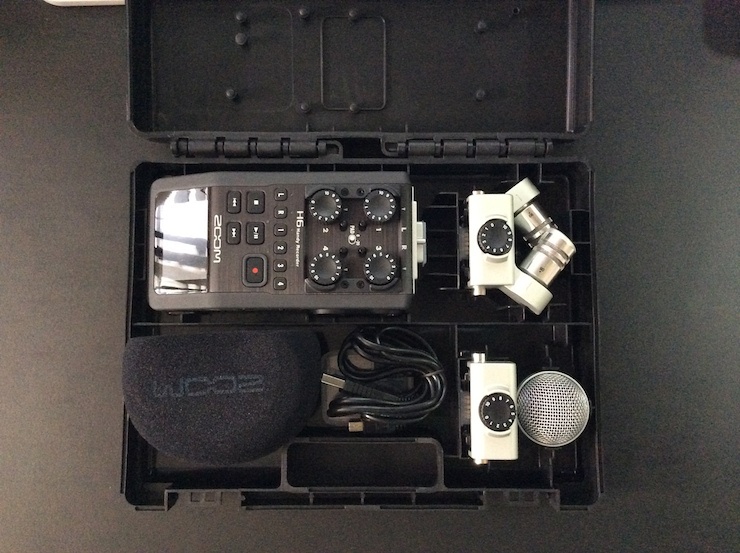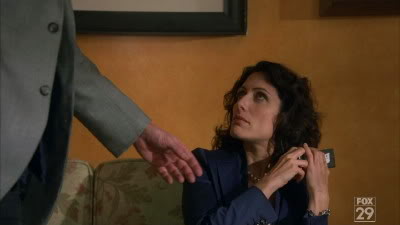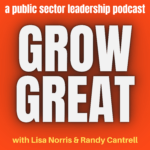Podcast: Play in new window | Download (Duration: 1:09:40 — 63.9MB)
Subscribe: Apple Podcasts | Spotify | RSS | More

Welcome to Episode 205, an inside look to the audio engine here in the Land of Bula. That Zoom H6 (pictured above) is the latest addition to the studio. It’s an incredible piece of equipment, capable of more than a single digital recorder ought to be capable of. Thanks to Patrick (my rep) at Sweetwater Sound, I got it about a month ago.
The unit comes with this hard shell case (notice the nice hinge system – it ain’t flimsy), a windscreen, a USB cable, two microphone interfaces and a small capacity SD card. I wish it had come with an AC power adaptor (an additional $24 or so by itself, or an additional $55 or so if you get it along with a bunch of other unnecessary accessories).
This unit will serve as a multi-channel digital recorder, but it also serves as a USB interface. It has 4 XLR/TRS hybrid inputs, each with its own individual pots. I’ve yet to record with it (other than a short test recording). The full color display is angled (as you can probably see by the photo) making it easy to see. It’s a solidly built unit with a rubberized outer surface.
The reason I was looking for a new unit was because my Roland R-09HR is growing increasingly unreliable due to lots of use. It’s been a great unit, but I was also looking for a unit with XLR/TRS inputs…and a unit capable of providing phantom power for my Rode NTG-2 (which can also be powered by AA batteries).
But let’s go back a bit, shall we?
Episode 76 was the first go round of giving folks a peek inside The Yellow Studio. Numerically, that was 130 episodes, but there are many unnumbered episodes. And there are other podcasts that have come out of The Yellow Studio.
I confess that not much has changed over the years, but I also know how geeky we podcasters can be. I love to see studios. And find out what gear people are using, and how they’re using it.
I know you’d like some logical approach to knowing more about The Yellow Studio. For starters, let’s talk about the name. Just look at the photo gallery and you’ll see the color of the walls. People often ask, “Why yellow?” Why not?
Truth is, I love yellow, orange, red and hunter green. Those are among my favorite colors. I don’t have just one.

When I was 15 – yes, people, when I was young, living in Louisiana…you could get your driver’s license at 15 – I had a 1954 GMC pickup truck. It was an old truck some farmer had abandoned in a field.
My maternal grandfather bought it for $150 and got it running, then paid somebody a little bit to recover the seat in new vinyl. It was a “3-on-the-tree” transmission and I drove it back from Oklahoma, where my grandparents lived, all the way back to Louisiana.
No air conditioning. No radio. Bare bones classic truck in faded hunter green.
I loved it. So much that when I got it home a buddy and I painted it hunter green with orange fender flares. With a brush! And it looked good. Of course, it looked better if you were standing a few feet away. 😉
During high school I had great fun with that truck. My first “real” car was a Pontiac Lemans. It was “Sundance Orange” – that’s what GM called it. So orange was always a big player for me. So, why not The Orange Studio?
I never considered walls being orange. Frankly, it just seemed too dark and I wanted something lighter. I had a moment of clarity when the TV show HOUSE aired. His boss, Cuddy, had yellow walls in her office. Mustard yellow. The exact shade I knew I wanted when I first “built” the Yellow Studio. Of course, it wasn’t so named at the time.

The moment I saw Cuddy’s office I told my wife, “That’s the color I want to paint the walls.” She and Dena, a close friend, painted it after finding the right shade of yellow. So that’s how the name came to be.
What else about the physical space?
– It’s a room about 13′ x 14.5′.
– There’s an adjoining bathroom.
– It has a small closet, filled with too many cables and other audio paraphernalia.
– It has 2 large windows with wooden slat shutters on the inside.
– It has an overhead florescent light, which rarely gets turned on.
– There are 4 full height bookcases behind my desk (out of seen most of the time) filled with books.
– There are 3 other 5′ high bookcases in the studio, also filled with books.
– There is one 4′ high bookcase filled with books, and a Polk Audio HD clock radio, plus a 3 monkeys lamp (hear no evil, see no evil, speak no evil).
– There is a CD carousel in the corner that houses 2000 CD’s with more stashed here and there.
– There’s one 2-drawer lowboy filing cabinet (lateral files or regular – it can configured either way).
– There’s 3 chairs that can sit around the “broadcast table” which is actually a conference table.
– The floor is carpeted with a light green low plush carpet.
– The ceiling has popcorn texture circa 1980’s (yeah, I hate it but it’s a royal pain and major mess to change it).
– The room has one HVAC vent without a vent fixture to prevent any rattling. Air just drops into the room.
Okay, enough about the actual space. Now for the stuff you really care about.
Here’s a list of the cool stuff (these are not affiliate links; I do have an affiliate list for most of my resources here):
• Herman Miller Mirra chair (I ditched it for the time being ’cause it’s never worked properly; need to take it in for service)
• Apple iMac 27″ with i7 processor (16GB RAM / 1TB Hard Drive)
• Apple iPad Air (128GB with ATT capability)
• Ambrosia Wiretap Studio ($69 – well worth it)
• Audio Hijack Pro by Rogue Amoeba
• Twisted Wave (my DAW of choice)
• Dialog by Wave Arts (my audio plugin of choice)
• Ambrosia Soundboard (sound cart software; this is $49)
• Sound Byte by Black Cat Systems (my main sound cart software)
• ID3 Editor (to create ID tags)
• Transmit by Panic is my ftp program of choice
• Call Recorder by ECamm (the software I use to record Skype calls – when I don’t use Wiretap Studio)
*Watch an episode of Mixergy.com with Andrew Warner to see how this software records video Skype calls
• Edirol R-09HR digital recorder
• Broadcast Tools ProMix12 broadcast console/mixer
• Zoom H6 multi-track digital recorder
• Yamaha MG124C mixer
• Heil Sound PR40 microphones (they’re my oldest pieces of gear)
• Heil Sound SM1 Shock Mounts
• Heil Sound PL2T Booms
• Heil Sound RS1 boom 12″ extension mount (for one mic; the other mic uses the C clamp)
• VAC pop filters for each PR40
• Heil Sound foam pop filter (I have one of these in case I want to take a PR40 out in the field to use; never happens, by the way)
• Giant Squid Cardioid Stereo mics (I know they’re great ’cause I’ve used them before; unfortunately, mine have never worked)
• Electro-Voice RE50B microphones (I have two of these for field use, but they work equally well in the studio)
• Rode NTG-2 shotgun microphone (it’s a condenser requiring phantom power, but has battery power capability built right in)
• Aphex 230 Voice Channel Processors (one for each PR40 mic)
• TC Electronic Finalizer Express (a final processor that handles everything going through the board)
• Telos One Phone Hybrid
• PreSonus FP10 Firewire Interface (awful customer service; I would not buy these again)
• PreSonus FireStudioProject Firewire Interface (I’m ditching these because I HATE PreSonus)
• Panamax power management
• Aphex Headpod 454 Headphone Amp (now called a HeadPod 4)
• Kensington Keyboards
• Sennheiser HD25-MKII headphones
• Kodak Zi8 HD video camera
• Audio Technica ATR3550 corded lapel microphone
• Logitech 1080p Webcam Pro C910
• Webcam Settings (an app that is terrific for managing webcam settings)
• ScreenFlow by Telestream (screen capture and video recording software)
• Camtasia For Mac (I got it in a Mac Bundle deal for $14 so I had to buy it; it’s a great alternative to ScreenFlow)
• iMovie by Apple (also for some video recording)
• Apple QuickTime Pro (can record audio, video or screen capture)
• Camera Stabilizer (this is great; buy one if you don’t have one)
• Vonage VOIP phone service (this feeds the phone hybrid)
• Apple AirPort Extreme (the old flat square version)
• Various hard drives back it all up
• Toshiba 42″ HDTV on the wall (maybe my most used piece of gear)
• Lots of my gear came from the fine folks at BSWUSA.com (shout out to Kelley Sullivan; she’s been terrific to deal with through the years)
Today’s episodes may go deeper (and darker) than you want, but that’s what the STOP button is for, right? I hope you enjoyed the tour.
Thanks for listening for all these years. I know the podcast here has morphed and changed over time, but that’s what we do as people. We grow. We change. Hopefully, we improve. I’m still working on it.
Do you have a podcast? Let me know about it.

 About the hosts: Randy Cantrell brings over 4 decades of experience as a business leader and organization builder. Lisa Norris brings almost 3 decades of experience in HR and all things "people." Their shared passion for leadership and developing high-performing cultures provoked them to focus the Grow Great podcast on city government leadership.
About the hosts: Randy Cantrell brings over 4 decades of experience as a business leader and organization builder. Lisa Norris brings almost 3 decades of experience in HR and all things "people." Their shared passion for leadership and developing high-performing cultures provoked them to focus the Grow Great podcast on city government leadership.
The work is about achieving unprecedented success through accelerated learning in helping leaders and executives "figure it out."



















